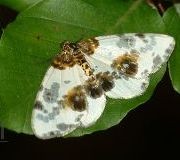Clouded magpie
(Abraxas sylvata)

Description
Abraxas sylvata, the clouded magpie, is a Palearctic moth of the family Geometridae that was named by Giovanni Antonio Scopoli in 1763. This moth is mostly white with brownish patches across all of the wings. There are small areas of pale gray on the forewings and hindwings. They resemble bird droppings while resting on the upper surface of leaves.The wingspan is 38 mm. to 48 mm. The wings are thinly scaled and partially transparent, with a white ground colour. The forewings are yellow-brown at the base and have a large, yellow and black spot at the dorsal edge, otherwise scattered, light grey spots, some of which form a cross-band in the outer part of the wing. The hindwings have a yellow and black spot at the edge of the inner edge, otherwise scattered, light grey spots. The larva has black and yellow longitudinal stripes. The species can be found from Europe to Japan. The moth can be found in forests, thickets, and sometimes parks on various deciduous trees. The adults fly from late May to early August. They are attracted to light. The moth is nocturnal and is easy to find during the day. They are easy to find resting during the morning. The moth starts being active at early dusk. The moths eat the plants Betula, Corylus, Fagus, Ulmus, Prunus, and Frangula. Caterpillars appear from mid-July to early October. They overwinter as a pupa. The body of the caterpillar is distinctive because it is marked with longitudinal black and yellow stripes. The caterpillars feed on wych elm and European elm. The pupa hibernates underground. The caterpillars live on several deciduous trees such as Fagus sylvatica, Ulmus glabra, and Ulmus procera. Abraxas, the magpie moths, is a genus of moths in the family Geometridae. It was first described by William Elford Leach in 1815. Palpi porrect (extending forward) and roughly scaled. Hind tibia of male dilated with a fold containing a tuft of hair. Forewings with vein 3 from before angle of cell and veins 7, 8, 9 and 10, 11 stalked. Vein 11 becoming coincident with vein 12, or apparently absent. Hindwings with vein 3 from before angle of cell.
Taxonomic tree:







